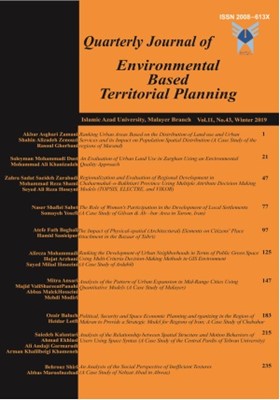Ranking Urban Areas Based on the Distribution of Land use and Urban Services and its Impact on Population Spatial Distribution (A Case Study of the regions of Marand)
Subject Areas :Akbar Asghari Zamani 1 , Shahin Alizadeh Zenouzi 2 , Rasoul Ghorbani 3
1 - Associate Professor of Geography and Urban Planning, University of Tabriz,
2 - Ph.D. student of Geography and Urban Planning, University of Kharazmi, Tehran, Iran
3 - Professor of Geography and Urban Planning, University of Tabriz, Tabriz, Iran
Keywords: spatial distribution, Marand, Spatial justice, Urban services, capitation,
Abstract :
The amount and distribution of municipal service applications can play an important role in the space mobility in urban areas and cause population and demographic changes. Since one of the criteria for sustainable development is a balanced distribution of population, providing urban services and applications should be spatially fair and well balanced. In the present study, the city of Marand with 12 types of services and urban uses has been examined. The objectives of this study are to investigate the distribution and use of services in various areas of Marand and ranking those areas according to the existing capita in these areas as well as the recognition of the balance of demographic balance in the urban areas as well as identifying the effect of distribution services on demographic imbalance in the area. In order to achieve the first objective VIKOR and SAW models and CopLand model were used. For achieving the second goal Spearman model was used. The results showed that the distribution of services is not manipulated well in Marand and the results of all three models Vikor, Saw, and Cap Land model showed that districts 1 and 3 had the first and second rank as far as access to services is concerned and the fifth district had the last rank. A comparison between the obtained results and those of Spearman shows that there is no significant relationship between the population and capita distributions.
1- اصغرپور، م. 1388. تصمیمگیریهای چند معیاره. چاپ دهم. انتشارات دانشگاه تهران. 234 صفحه.
2- بحرینی، س ح.1377. فرآیند طراحی شهری. چاپ دوم. انتشارات دانشگاه تهران. 79 صفحه.
3- بردی آنامرادنژاد، ر. 1388. مدخلی بر فقر شهری با تأکید فقر مسکن در نقاط شهری کشور. فصلنامه پژوهشهای جغرافیای انسانی. سال اول، شماره سوم. 67-83.
4- پورطاهری، م. سجاسی قیداری، ق. صادقلو، ط. 1388. سنجش و اولویتبندی پایداری اجتماعی در مناطق روستایی، با استفاده از تکنیک رتبهبندی بر اساس تشابه به حل ایدهآل فازی. فصلنامه پژوهشهای روستایی. سال اول. شماره اول. 1- 13.
5- پورمحمدی، م. 1387.برنامهریزی کاربری اراضی شهری. چاپ چهارم .انتشارات سمت. 104 صفحه.
6- حاتمی نژاد، ح. 1387. تحلیل نابرابریهای اجتماعی در برخورداری از کاربریهای خدمات شهری. مجله پژوهشهای جغرافیای انسانی. سال چهارم. شماره 65. 71-85.
7- خاکپور، ب. 1388. بررسی و تحلیل نابرابری در سطوح توسعه یافتگی مناطق شهر مشهد. مجله دانش و توسعه. سال دوم.شماره 27. 182-202.
8- داداشپور، ه. رستمی، ف.1390. بررسی و تحلیل نحوهی توزیع خدمات عمومی شهری از دیدگاه عدالت فضایی(مورد، شهر یاسوج) مجلة جغرافیا و توسعه ناحیهای. سال چهارم. شمارة شانزدهم. 171- 198.
9- رضویان، م.1381. برنامهریزی کاربری اراضی شهری. چاپ اول.انتشارات منشی. 68 صفحه.
10- شکویى، ح.1375. اندیشههاى نو در فلسفه جغرافیا. تهران. چاپ اول. گیتاشناسى. 143 صفحه.
11- عبدی دانشپور، ز. 1378. تحلیل عدم تعادل فضایی در شهرها، مورد تهران. مجله صفه. سال نهم. شماره بیست و نهم. 37-49.
12- . عزیزی، م.1381. تأسیسات زیربنایی شهری، نگاهی به یک تجربه. مجله شهرداریها. سال چهارم. شماره سی و هفت. 39-51.
13- عطائی، م. 1389. تصمیمگیری چند معیاره. چاپ اول. انتشارات دانشگاه صنعتی شاهرود.61 صفحه.
14- هادی پور، ح . فرهودی، ر. پور احمد. احمد. 1385. معیارهای مؤثر در مرزبندی نواحی مناطق شهری(منطقه یک شهرداری تهران). فصلنامه پژوهشهای جغرافیایی. سال پنچم. شماره پنچاه و هفت.93-111.
15- د،هاروی. 1379. عدالت اجتماعی و شهر، ترجمه فرخ حسامیان و محمدرضا حائری، انتشارات شرکت پردازش و برنامهریزی شهری، چاپ دوم .تهران.115 صفحه.
16- وارثی، ح.1387. بررسی تطبیقی توزیع خدمات عمومی شهری از منظر عدالت اجتماعی. نشریه جغرافیا و توسعه. سال دوم. شماره 66، 139-156.
17- Dufaux, F. (2008), Birth announcement,justice spatial/spatial justice. www.jssj.org.
18- Kunzmann, K R. (1998). planning for spatial equity in Europe. International Planning Studies 3(1). 101–121.
19- Pietro, G., Elliott, D., and Gabriell, Y. 2005. A Home in the City, UN Millennum Project, Task Force on Improving the Lives of Slum Dwellers, London
20- Soja, E.(2006), The city and spatial justice, justice spatial/spatial justice, www.jssj.org.
21- Jingzhu,W. Xiangyi, L.(2008), The Multiple Attributed Decision-Making VIKOR Method and Its Application, IEEE.
22- Widner,R. (2003).planning law primer, basics of variances planning commission
23- journal, number 50.
-
_||_

